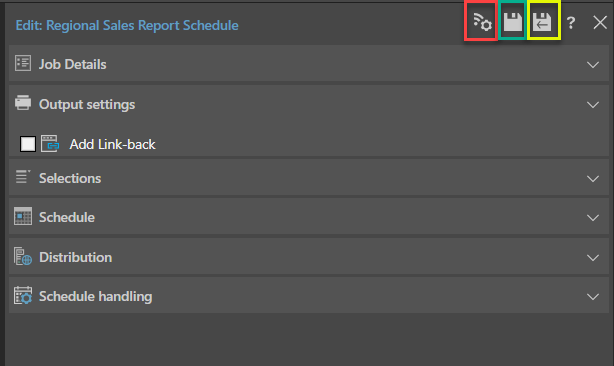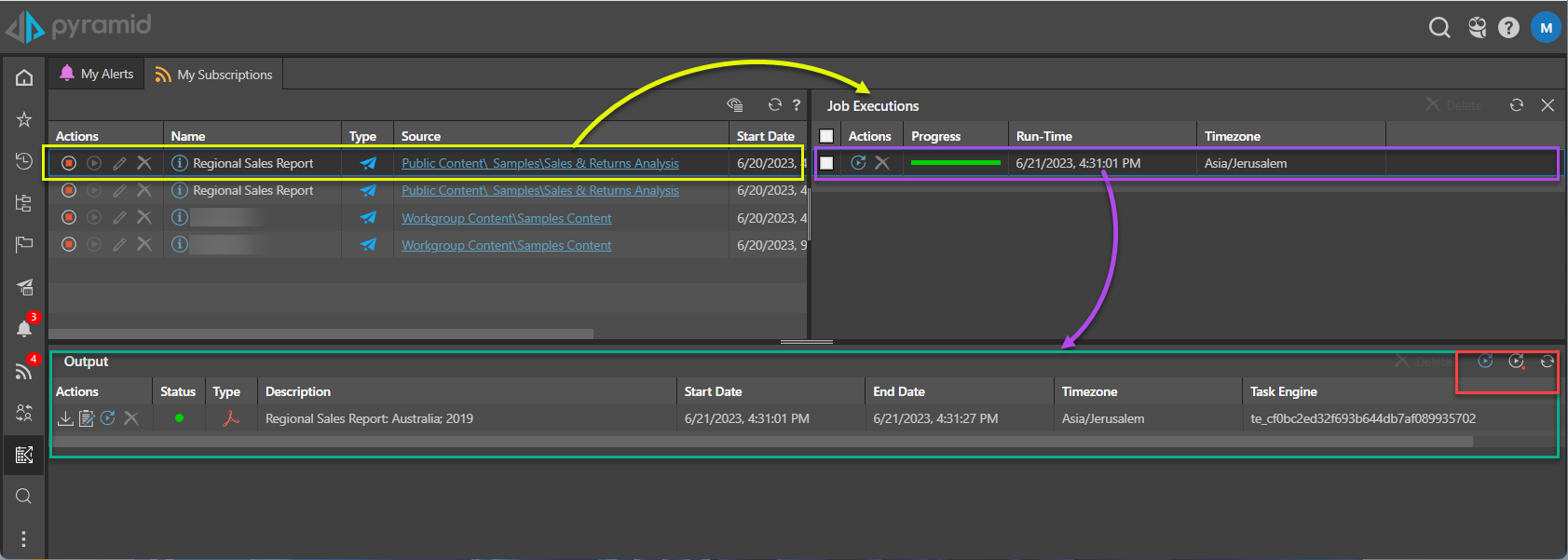Manage and edit subscription schedules to discoveries, presentations, and publications from Subscriptions Manager. Here you can see a list of subscription schedules, edit subscription schedules, and view job executions and outputs for specified subscription schedules.
My Subscriptions Workspace
Click the My Subscriptions tab (yellow highlight below) to open the Subscriptions Manager.
Subscriptions List
The list of subscription schedules is displayed in the middle of the workspace (purple highlight below)
Each listed subscription will display the following columns:
- Actions: from the actions column, you can stop, start, edit, or delete a schedule.
- Name: the name of the schedule.
- Type: the icon indicates the content type (data discovery, presentation, or publication).
- Source:shows the folder path to the content item.
- Start Date: the date and time at which the schedule started or will start.
- End Date: the date and time at which the schedule ended or will end (if the schedule is recurring and an end time and time was defined).
Subscriptions Macro Buttons
The macro buttons (green highlight below) let you:
- Show All: show all subscription schedule jobs, both active and inactive.
- Hide Inactive: show active subscription schedule jobs only.
- Refresh: refresh the subscription schedule listing.

Edit a Schedule
All schedules can be edited to adjust their settings and configuration. When editing an existing schedule, you can toggle between basic and advanced settings (red highlight below), and there are two options for saving changes to the schedule:
- Save: click the Save icon (green highlight below) to save changes to the schedule without running it.
- Save & Run: click the Save & Run icon (yellow highlight) to save changes and run the scheduling job.
- Click here to learn how to configure subscription and subscription schedules.
Advanced Schedule Settings
Advanced schedule settings are available from the Alerts Manager. Click the advanced settings icon (red highlight below) to toggle them on and off. The advanced schedule settings include:
- Schedule Handling: set the amount of time to keep the content and associated logs in the system before they are auto-purged.
- Schedule Timeout: Disables the scheduled task after the given amount of time.
- Disable Schedule after Consecutive Failures: The maximum amount of consecutive failures allowed before the schedule is disabled.
- Time to Keep the Published Output: Sets the amount of time to keep rendered content including printing, publications, and subscriptions. The time set here cannot be greater than the overriding time set by the administrator in the system schedule.
Note: Selecting System Default for these options applies the default setting created by your administrator in the System Schedule.

Job Executions
Each time a schedule is run, it creates a "job". To view the historical list of job executions for a particular schedule, click on the schedule item (yellow highlight below) in the list to show all its current and previous job executions (purple highlight below). Each listing in the job executions will display the following columns:
- Actions: the option to re-run the entire job.
- Progress: shows the progress of the job, showing the percentage of separate tasks and their status
- blue indicates the number of tasks that are currently waiting in queue to be processed
- yellow is the number of tasks that are currently processing,
- red is the number of tasks that have failed
- green is the number of tasks that completed successfully.
- Run-Time: the date and time that the job was run.
- Timezone: the timezone of the schedule.

Subscription Outputs
You can view the output of a specific job execution by clicking on the job's execution listing (purple highlight above). This will open the Output panel (green highlight above) for the selected job execution.
The Output list for subscriptions displays the following columns:
- Actions: the option to re-run the entire job.
- Status: displays the status of the job execution's output.
- red - a specific task that failed
- orange - a specific task that partially failed
- green - a specific task that was fully successful
- Type: the output type (PDF, Word, Excel etc)
- Description: the name of the schedule job.
- Start Date: the date and time that the job execution's output started running.
- End Date: the date and time at which the schedule ended or will end (if the schedule is recurring and an end time and time was defined).
- Timezone: the timezone of the schedule,
- Task Engine: the task engine that processed the scheduled task.
Output Macro Buttons
The output panel's macro buttons (red highlight above) enable the following:
- Rerun All: rerun all schedule jobs.
- Rerun All Failed: rerun all schedule jobs that failed.
- Refresh: refresh the list of outputs.